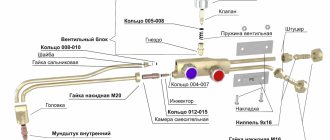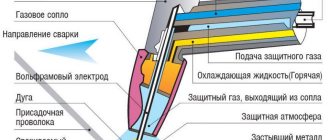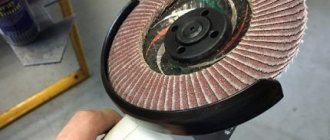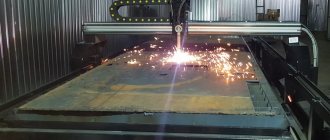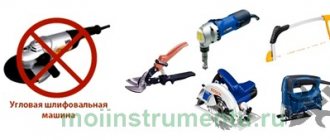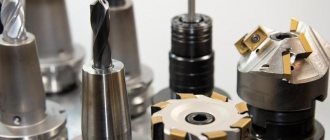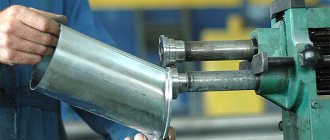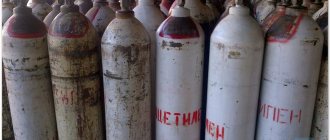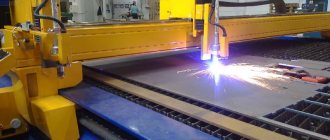| Place | Name | Characteristics in the rating |
| The best gas cutters for metal |
| 1 | Krass Р3П-300 | The best choice |
| 2 | REDIUS Р2А-01М | Lightweight design |
| 3 | DONMET RK Vognik 182 | Universal plasma torch |
| 4 | KEDR R3P-05 1390036 | Long design |
| 5 | Svarog RZ 62-3F 1C005-0012 | Best Lever Blow Cutter |
| Best Handheld Metal Cutters |
| 1 | Pathfinder-GTP-S05 | Best manual cutter |
| 2 | Campingaz Chalugaz profile | Most comfortable handheld design |
| 3 | Kovea KT-2008 | Convenient cutter for small jobs |
| 4 | Pathfinder GTP-R03 | Compact tool |
| 5 | Kovea KT-2911 Long Canon | Hand torch with extended nozzle |
There are many ways to cut metal, but the most effective, simple, and, oddly enough, safe is the gas method. The essence of the technology is based on the chemical interaction of flammable gas, in most cases propane, with oxygen. As a result of this synthesis, a directed flame is formed with a high temperature in the center, which reaches the melting point of steel.
A more modern method is plasma cutting. The technology is similar, only an electric arc acts as the jet activator. A plasma cutter is capable of creating a thinner cut, but if in the case of propane it is enough to acquire only two gas cylinders (with propane and oxygen), then you will need a special device - a plasma torch.
When choosing a cutter, you should first of all pay attention to its ergonomics and convenience. Typically, the cutting process takes many hours, and some places are very difficult to reach. The design of the cutter is selected individually, depending on the tasks assigned. We also look at the safety of the tool, but if we talk about our rating, which includes the 10 best cutters, then this parameter is present in all models, regardless of their price category.
The best gas cutters for metal
A gas cutter consists of several modules: a holder, a valve system, tubes and a nozzle. Each model has its own characteristics. For example, the nozzle should be equipped with kickback protection, and the handle should fit comfortably in the hand and not slip out. When choosing, special attention is paid to the valve system, which bears the main load during operation. The location of the valves also matters in terms of convenience, and in some models the purge valve is replaced with a lever. Such tools are also presented in our rating.
Classification according to the combustible gas used
Propane
Propane gas cutters are ideal for processing cast iron pipes and other products made from ferrous and non-ferrous metals. Propane gas cutters are rightfully considered the most reliable and safe and at the same time are able to provide maximum work productivity.
Acetylene
Acetylene gas cutters are used for cutting sheet metal and large parts. Such devices must be equipped with a special valve that regulates the speed and power of oxygen supply to the work area.
Universal
Universal injection-type gas cutters are the most in demand today. These devices allow you to use the power of the working gas if the pressure inside the housing is from 0.03 to 1.5 kgf/square centimeter. The universal cutter is simple and easy to use, has relatively small dimensions and is capable of cutting metal products in different directions. With its help, you can effectively process metal with a thickness of 3 to 300 mm in thickness.
Instructions for use
The cutting technology involves initially setting the ratio of oxygen and propane at 1 to 10 – i.e. at an oxygen pressure of 6 atm. The flammable gas pressure is set to 0.6 atm.
Opening and closing the gas supply is carried out in a strict sequence:
- The oxygen and flammable gas valves open 0.5 turns (strictly in that order).
- The flammable mixture is ignited.
- The torch is brought to the metal being cut and by opening the valve, the supply of oxygen is added until a cutting jet appears.
- After completion of the work, the supply of flammable gas is initially shut off, and then oxygen.
Figure 7. Scheme of the process of oxygen cutting of metal
The cutting technique after igniting the torch involves the need to heat up the metal area in the cutting area. If the heated area becomes red, the oxygen supply can be increased a little more. After completely cutting through the workpiece, the torch moves along the cutting line. The speed of movement of the cutter depends on the thickness of the rolled metal being cut, the operating characteristics of the process, and therefore is determined individually.
The following video shows how to properly use a gas cutter:
Where can I buy
The product can be purchased in our online store or at one of the warehouses in Moscow. You can receive your order yourself or by ordering delivery.
Delivery
When ordering goods with a total weight of up to 6 kg, the cost of delivery by courier is 400 rubles
, you can order such delivery by selecting the cutter or other product you need in the Catalog section.
Delivery costs exceeding 6 kg depend on your location. Regular delivery in Moscow costs from 1,200 rubles
.
Delivery can be ordered by phone: +7
.
Delivery orders are open on weekdays from 9-00 to 17-00, on Saturdays from 10-00 to 14-00, and on the website - around the clock
. All warehouses are open on weekdays from 9-00 to 17-00, and on Saturdays from 10-00 to 14-00.
Safety precautions
It is better to entrust metal cutting using a gas installation to an experienced specialist, since if handled carelessly, the consequences can be quite tragic.
Safety precautions presuppose the following conditions:
Gas burner device
- good ventilation in the room where the work will be carried out;
- there should be no gas cylinders or other flammable substances within a distance of 5 meters;
- work must be carried out wearing a protective mask or special glasses, as well as fire-resistant clothing;
- the flame must be directed in the opposite direction from the gas source;
- During operation of the device, hoses must not be bent, stepped on, or pinched with feet;
- If you take a break, you should completely extinguish the flame at the burner and tighten the gas valves of the cylinders.
Compliance with these simple conditions will ensure safe and efficient work when cutting metal with a gas installation.
Conditions for cutting metal with gas
Gas cutting of metal will be effective only when the ignition temperature of the metal is lower than the melting point. Such proportions are observed in low-carbon alloys; they melt at 1500 °C, and the ignition process occurs at 1300 °C.
For high-quality operation of the installation, it is necessary to ensure a constant supply of gas, since oxygen requires a constant amount of heat, which is maintained mainly (70%) by the combustion of metal and only 30% is provided by the gas flame. If it is stopped, the metal will stop producing heat and oxygen will not be able to perform its functions.
Cutter operation, metal cutting training
The maximum temperature of hand-held gas cutters reaches 1300 °C, this is a sufficient value for processing most types of metal, however, there are those that begin to melt at particularly high temperatures, for example, aluminum oxide - 2050 °C (this is almost three times more than the melting point of pure aluminum), steel containing chromium – 2000 °C, nickel – 1985 °C.
If the metal is not sufficiently heated and the melting process has not begun, oxygen will not be able to displace refractory oxides. The opposite of this situation is when the metal has a low melting point and, under the influence of burning gas, it can simply melt, so this cutting method cannot be used for cast iron.
Preparing for work
Before you start working with gas cutting equipment, you need to prepare. It includes actions that reduce the risk of damage to the device, workpiece, and injury. Preparation stages:
- Inspect the cylinders, connecting hoses, fasteners, and burner for damage. They must be intact, without visible defects.
- Sniff the surrounding air. This way you can detect a gas leak. Initially, you need to connect the hoses to the cylinders and the burner, clamp them with clamps. The flammable mixture should not burst out.
- Rubber seals must be intact. If cracks appear on them or their shape changes, it is necessary to immediately replace the gaskets with new ones.
- Before opening the oxygen valve, it is necessary to check the equipment for grease stains and oil leaks. Even small amounts of these substances can cause an explosion.
It is important to connect the hoses correctly without confusing the gas supply.
Preparing to use a cutting torch
Advantages and disadvantages
Any tool has its pros and cons, and a gas cutter is no exception. Among the advantages of modern devices with intra-nozzle gas mixing, the following should be noted:
- The relatively large thickness of the metal being cut is up to 300 mm, depending on the modification and operating parameters (gas used and oxygen pressure).
- Stable flame burning without pops or backfires.
- Possibility of cutting steel in any direction, regardless of thickness.
- High performance.
- Easy to maintain and long service life.
Photo 4. Oxygen gas cutting process
However, it has no less disadvantages:
- As a result of strong heating, the cut parts may become deformed (especially those made of thin sheet metal).
- The cutting width is quite large, which requires compliance with certain allowances during marking work.
- Low quality of cut - uneven edges with oxides and scale. Therefore, before welding or other work, pre-treatment of the edges is required.
- Quite a high cost of the oxy-fuel cutting process.
Plasma cutters
Some types of work cannot be carried out with gas appliances, then the best option is to buy a plasma cutter. However, it is important to understand that such devices differ from each other not only in special capabilities, but also in design. Also, there are differences in the method of igniting the arc and the cooling system used.
There are compact mobile models that can be easily transferred from one point to another. In addition to this option, there are entire portal installations that are designed to perform complex production tasks.
Most plasma cutters are divided into 5 categories:
- Devices designed to perform assigned tasks in an environment of inert and protective gases.
- Models capable of operating in an oxidizing environment – places with high oxygen levels.
- Devices designed for forming with various mixtures.
- For use in stabilizers.
- Equipment with magnetic stabilization.
Also, the differences between devices occur based on the type of energy consumed. Thus, there are household cutters that are actively used to perform simple tasks and operate on a voltage of 220 V. Professional devices operate only on 380 V, but their scope of application is several times larger.
It is important to understand that regardless of the energy consumption and power rating, it is necessary to check the device connected to the general network. In addition, it is worth remembering that a compressor with average power is connected to the cutter. Therefore, it must also be taken into account when connecting.
Inverter type cutters
This is one of the best budget options that can handle metal whose thickness will not exceed 30 mm. Such models are in high demand for carrying out small work in the household or in small workshops. Also a big plus is the low electrical energy consumption and compactness.
90% of the models sold are easy to transport. This makes it possible to work in hard-to-reach places. In addition, a big plus is the efficiency, which is 30% higher.
Transformer type metal plasma cutters
More expensive devices designed to perform average work. They are capable of cutting metal up to 80 mm thick. In appearance they resemble a large box, the movement of which occurs due to wheels. The weight and dimensions are correspondingly greater than the previous model.
The reliability of such devices is many times higher. Even if power surges occur, transformer-type plasma cutters will not fail, and this makes it possible to work in regions where there is a problem with electricity.
Also an additional advantage is the operating time with uninterrupted switching on, which is almost 100%. Therefore, the device is able to function throughout the whole day without any interruptions. However, despite the positive features, such models also have a negative side: high energy consumption.
In addition to dividing models by type, cutters are also distinguished by the type of contact. So there are contact and non-contact devices. The first model is capable of working with metals whose thickness does not exceed 18 mm, and the second option operates with any thickness.
Device and design features
An oxy-fuel cutter is used to mix a mixture based on fuel (acetylene, propane) and cutting gases (oxygen) to produce a cutting jet.
Structurally, a gas cutter for cutting metal consists of the following elements:
- special head with two replaceable mouthpieces;
- tubes for supplying oxygen and gas;
- mixing chamber for forming a mixture of fuel and cutting gases;
- 3 valves – for flammable gas, supply and regulation of the amount of oxygen supplied;
- lever.
These are the main components of an oxy-fuel cutting tool as there are many other parts to its design.
Figure 1. Diagram of an oxy-fuel torch
